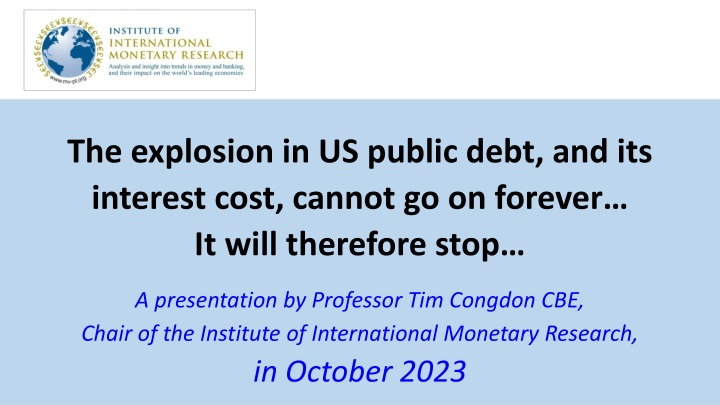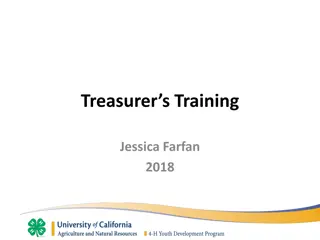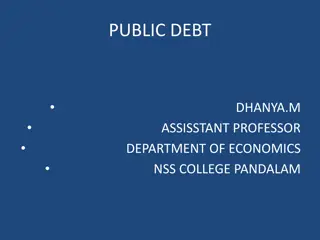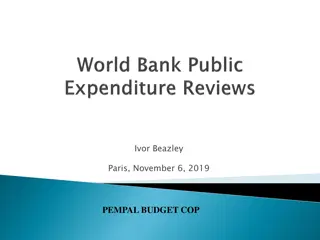
Insights into US Public Debt and Deficit Trends
Explore Professor Tim Congdon's analysis on the explosion in US public debt, the underlying Federal deficit, and the IMF's revised view of US public finances in 2023. Discover the impact of these economic factors on the country's financial landscape.
Download Presentation

Please find below an Image/Link to download the presentation.
The content on the website is provided AS IS for your information and personal use only. It may not be sold, licensed, or shared on other websites without obtaining consent from the author. If you encounter any issues during the download, it is possible that the publisher has removed the file from their server.
You are allowed to download the files provided on this website for personal or commercial use, subject to the condition that they are used lawfully. All files are the property of their respective owners.
The content on the website is provided AS IS for your information and personal use only. It may not be sold, licensed, or shared on other websites without obtaining consent from the author.
E N D
Presentation Transcript
The explosion in US public debt, and its interest cost, cannot go on forever It will therefore stop A presentation by Professor Tim Congdon CBE, Chair of the Institute of International Monetary Research, in October 2023
The underlying Federal deficit in the USA 1. The Federal deficit in the year to September 2023 was just under $1,700b., much less than I suggested in my special e-mail of 4thSeptember. (I suggested it might be $2,200b. almost 50% above the Congressional Budget Office estimate as recently as May 2023.) Even so, the outcome is above the CBO May estimate, and more seriously it has clearly been brought down to a respectable number by deliberate postponement of spending by the US Treasury at the end of the fiscal year. In August 2023 Federal spending was 63% lower than a year earlier and in September it was 30% lower! The 63% fall in the month compared with a year earlier was the largest in over four decades!! despite 2023 being a year of cost pressures and soaring interest on the Federal debt.
US Federal outlays - monthly data, % change on year earlier 250 200 150 100 50 0 LOOK AT THIS 2008-10-01 2011-10-01 2014-10-01 1981-10-01 1983-04-01 1984-10-01 1986-04-01 1987-10-01 1989-04-01 1990-10-01 1992-04-01 1993-10-01 1995-04-01 1996-10-01 1998-04-01 1999-10-01 2001-04-01 2002-10-01 2004-04-01 2005-10-01 2007-04-01 2010-04-01 2013-04-01 2016-04-01 2017-10-01 2019-04-01 2020-10-01 2022-04-01 -50 -100
The underlying Federal deficit in the USA 2. The underlying Federal deficit the deficit at present without the US Treasury gerrymandering between months is in the vicinity of $2,000b. - $2,500b. at an annual rate. This compared with nominal GDP in Q2 2023 of just above $27,000b., i.e., the underlying deficit is about 8% of GDP. As unemployment remains very low, the cyclically-adjusted (or so-called structural ) deficit is even higher, perhaps even as much as 10% of GDP.
The IMF's revised view of US public finances - Chart is of general government 'structural' balance as % of GDP 0 -2 -4 -6 -8 -10 Apr-23 Oct-23 -12 In only six months the IMF raised its estimate of the USA s structural budget deficit in 2023 by 2% of GDP.
General government gross debt, % of GDP, as projectd by the IMF in October 2023 160 140 120 100 80 60 The projection is for a ratio of government debt to GDP higher than that in Italy over most of the last 30 years. 40 20 0
Why does the public debt explosion matter? No nation has experienced a ratio of public debt interest to GDP of more than 15% for more than a year or two. ( Congdon s Law first proposed in a column for Standpoint magazine a few years ago.) The limit is on debt interest to GDP, not debt to GDP, contrary to the Reinhart and Rogoff 2011 This Time It s Different book. (They proposed a 90%-of-GDP public-debt-to-GDP ratio tipping point.) If the average interest rate being paid on a nation s debt is 8%, something will happen before public debt exceeds twice GDP. Of course, if the average interest rate is 4%, there is more scope for incurring debt.
US Treasury bill rate, %, 1934 - 2023 18 16 Last value is September 2023. 14 12 10 8 6 4 2 0
Debt interest payments as % of US GDP 6 Last value is 2nd quarter of 2023. 5 4 3 2 Further sharp rises in the ratio are to be expected because of the latest increase in bond yields and the expected rise in the ratio of debt to GDP. 1 0
Further sharp rises in the debt Further sharp rises in the debt- -interest to to- -GDP ratio GDP ratio perhaps to a figure perhaps to a figure above the 5% seen in the 1980s under above the 5% seen in the 1980s under President Reagan President Reagan are to be expected because of the latest increase in bond because of the latest increase in bond yields and the widely expected rise in yields and the widely expected rise in the ratio of debt to GDP. the ratio of debt to GDP. interest- - are to be expected
Paul Krugmans verdict On 10th October Paul Krugman the world s most influential economist used his New York Times column to pronounce The deficit is indeed too high. We won t do anything about it. The recognition that the US budget deficit is too high was remarkable coming from Krugman, given his long-standing Keynesian credentials and aversion to any measures of so-called fiscal tightening . But in his (very plausible) view the political context is such that neither Republicans nor Democrats will do anything in the next few years to bring the USA s public finances back to a sustainable trajectory. Trump and Biden have other things on their minds
Official Official projection projection from from Congressional Congressional Budget Office Budget Office September September 2020 2020
Official projection Official projection from Congressional from Congressional Budget Office Budget Office September 2020 September 2020 On the gross-debt-to- GDP measure, this chart signals a rise in the ratio to 230% by 2050. With bond yields at 5% - 7%......
Herbert Steins wisecrack Herbert Stein (1916 1999), one of the USA s most venerated conservative economists, wrote in his 1998 book of collected essays and reviews What I Think, - If something cannot go on forever, it will stop. The rise in the ratio of interest on the Federal debt to GDP cannot go on forever
Larry Summers warning Larry Summers, President Emeritus of Harvard University, said in an 18th September lecture to the Washington-based Peterson Institute, - I would suggest that substantial and accumulating deficits and debts are a substantial threat to national security and national power...[B]udget deficits a decade out comfortably in double digits as a share of GDP now seem a reasonable projection I think it is reasonable to ask the question: How long can or will the world s greatest debtor be able to maintain its position as the world s greatest power?






















